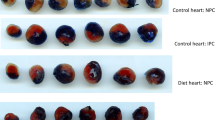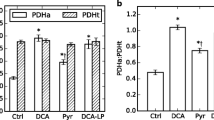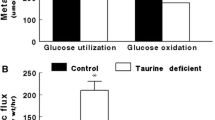Summary
The effect of the carnitine palmitoyltransferase 1(CPT1) inhibitor, Etomoxir, on glucose oxidation rates was determined in ischemic hearts reperfused in the presence of fatty acids. Isolated working rat hearts were perfused with 11 mM (14C)-glucose and 1.2 mM palmitate at a 15 cm H2O preload, 80 mm Hg afterload. Hearts were subjected to either 60 min aerobic perfusion, or 15 min work followed by 25 min global ischemia then 60 min of aerobic reperfusion. Steady state glucose oxidation rates in reperfused ischemic hearts were not significantly different from non-ischemic hearts. If 10−9 M Etomoxir was added immediately prior to reperfusion no significant change in glucose oxidation occurred. Addition of 10−8 M and 10−6 M Etomoxir, however, significantly increased glucose oxidation. Etomoxir also significantly improved recovery of mechanical function at a concentration of 10i−8 M or greater. As we previously reported, no significant improvement of function was seen when 10−9 M Etomoxir was added to the perfusate (Lopaschuk GD et al., Circ Res 63: 1036–1043, 1988). Long chain acylcarnitine levels were significantly reduced in the presence of both 10−9 M and 10−8 M Etomoxir. These data demonstrate that the beneficial effect of Etomoxir on reperfusion recovery of ischemic hearts is not due to a lowering of long chain acylcarnitine levels. Etomoxir may improve recovery of function by overcoming fatty acid inhibition of glucose oxidation.
Similar content being viewed by others
References
Oliver MF, Kurien VA, Greenwood TW: Relation between serum free fatty acids and arrythmias and death after acute myocardial infarction. Lancet 1: 84–86, 1968
Opie LH: Metabolism of free fatty acids, glucose and catecholamines in acute myocardial infarction. Am J Cardiol 39: 938–953, 1975
Mueller HS, Ayres SM: Metabolic response of the heart in acute myocardial infarction in man. Am J Cardiol 42: 363–371, 1978
Liedtke AJ, Nellis SH, Neely JR: Effects of free fatty acids on mechanical and metabolic function in normal and ischemic myocardium in swine. Circ Res 43: 652–661, 1978
Corr PB, Gross RW, Sobel BE: Amphipathic metabolites and membrane dysfunction in ischemic myocardium. Circ Res 55: 135–154, 1984
Idell-Wenger JA, Grotyohann LW, Neely JR: Coenzyme A and carnitine distribution in normal and ischemic hearts. J Biol Chem 253: 4310–4318, 1978
Feuvray D, Idell-Wenger JA, Neely JR: Effects of ischemia on rat myocardial function and metabolism in diabetes. Circ Res 44: 322–329, 1979
Molaparast-Saless F, Liedtke AJ, Nellis SH: Effects of the fatty acid blocking agents, oxfenicine and 4-bromocrotonic acid, on performance in aerobic and ischemic myocardium. J Mol Cell Cardiol 19: 509–520, 1987
Paulson DJ, Noonan JJ, Ward KM, Stanley H, Sherratt A, Shug AL: Effects of POCA on metabolism and function in the ischemic rat heart. Bas Res Cardiol 81: 180–187, 1986
Lopaschuk GD, Wall SR, Olley PM, Davies NJ: Etomoxir, a carnitine palmitoyltransferase I inhibitor, protects hearts from fatty acid induced ischemic injury independent of changes in long chain acylcarnitine. Circ Res 63: 1036–1043, 1988
Lopaschuk GD, Spafford M: Response of isolated working hearts from acutely and chronically diabetic rats to fatty acids and carnitine palmitoyltransferase I inhibition during reduction of coronary flow. Circ Res (in press)
Neely JR, Morgan HE: Relationship between carbohydrate and lipid metabolism and energy balance of the heart. Ann Rev Physiol 36: 413–459, 1974
Lopaschuk GD, Hansen C, Neely JR: Fatty acid metabolism in hearts containing elevated levels of coenzyme A. Am J Physiol 250: H351-H359, 1986
Lopaschuk GD, Tsang H: Metabolism of palmitate in isolated working hearts from spontaneously diabetic ‘BB’ Wistar rats. Circ Res 61: 853–858, 1987
Ichihara K, Neely JR: Recovery of ventricular function in reperfused ischemic hearts exposed to fatty acids. Am J Physiol 249: 11492–11497, 1985
Liedtke AJ, DeMaison L, Eggleston AM, Cohen LM, Nellis SH: Changes in substrate metabolism and effects of excess fatty acid in reperfused myocardium. Circ Res 62: 535–542, 1988
Liedtke AJ, DeMaison L, Nellis SH: Effects of L-propionylcarnitine on mechanical recovery during reflow in intact hearts. Am J Physiol 255: H169-H176, 1988
Opie LH, Owen P, Riemersma RA: Relative rates of oxidation of glucose and free fatty acids by ischaemic and non-ischaemic myocardium after coronary artery ligation in the dog. Eur J Clin Invest 3: 419–435, 1973
Bricknell OL, Opie LH: Effects of various substrates on lactate dehydrogenase release and on arrythmias in the isolated rat heart during underperfusion and reperfusion. Circ Res 43: 102–115, 1978
Taniguchi J, Noma A, Irisawa H: Modification of the cardiac action potential by intracellular injection of adenosine triphosphate and related substances in guinea pig single ventricular cells. Circ Res 53: 131–139, 1983
Myears DW, Sobel BE, Bergmann SR: Substrate use in ischemic and reperfused canine myocardium: quantitative considerations. Am J Physiol 253: H107-H114, 1987
Author information
Authors and Affiliations
Rights and permissions
About this article
Cite this article
Lopaschuk, G.D., McNeil, G.F. & McVeigh, J.J. Glucose oxidation is stimulated in reperfused ischemic hearts with the carnitine palmitoyltransferase 1 inhibitor, Etomoxir. Mol Cell Biochem 88, 175–179 (1989). https://doi.org/10.1007/BF00223440
Accepted:
Issue Date:
DOI: https://doi.org/10.1007/BF00223440




